Trey Anastasio, the legendary frontman and guitarist of Phish, is celebrated for his improvisational brilliance and distinctive guitar tone. A cornerstone of his sound is his collection of exceptional guitars, most notably his custom-built instruments by Paul Languedoc. These unique guitars, along with his prized acoustic collection, have played an integral role in shaping Trey’s signature sound and Phish’s musical journey. This article delves into the fascinating world of Trey Anastasio’s guitars, exploring the details of his most iconic instruments and what makes them so special.
The Languedoc Legacy: Trey Anastasio’s Electric Guitars
Paul Languedoc’s guitars are legendary in their own right, and Trey Anastasio’s long-standing relationship with these instruments has solidified their iconic status. What sets Languedocs apart is their unique construction: they combine the 25.5″ neck scale length typically found in Fender Stratocasters and Telecasters with the dual humbucker pickups more common in Gibson Les Pauls, ES-335s, or SGs. This combination is rare in mass-produced guitars, though famously featured in some of Jerry Garcia’s custom guitars.
This design choice results in a distinctive sonic profile. The longer scale length contributes a bright, “twangy” attack and clear articulation reminiscent of Fender guitars, while the humbuckers deliver a powerful, thick, and mid-range focused tone akin to Gibson’s hard rock sound. Trey himself describes the Languedoc tone as having “the bite of a Strat and … the meat of a hollowbody.” The fully hollow body construction, coupled with premium tonewoods and internal bracing like a violin, further enhances the guitars with a warm, resonant, and incredibly sustained tone.
Later Languedoc models for Trey incorporated coil-tapped humbuckers, adding versatility with single-coil tone options. Mini-switches, located beneath the lower F-hole, control pickup selection, coil-splitting, and series/parallel wiring configurations.
Around 2019, as Trey began exploring higher-gain amplifier setups, modifications were made to his Languedocs. The series/parallel mini-toggle was removed, and a pickup selector mini-toggle remained. This toggle offers humbucker selection in the middle position and inner or outer single-coil options in the outer positions. A push-pull pot was also introduced to control a Tip/Ring/Sleeve (TRS) stereo output. This TRS output allows Trey to send one side of the stereo signal directly to his amplifier, bypassing effects for a pure guitar-to-amp tone, while the other side feeds his Bradshaw effects rig, maintaining access to his extensive sound palette. This setup allows for a magical interaction between the guitar’s pickups and the initial preamp tube stage of his high-gain amps, a nuance prized by tone purists.
Let’s explore Trey’s main electric Languedoc guitars in detail:
#1: Old Reliable (“Mar Mar”)
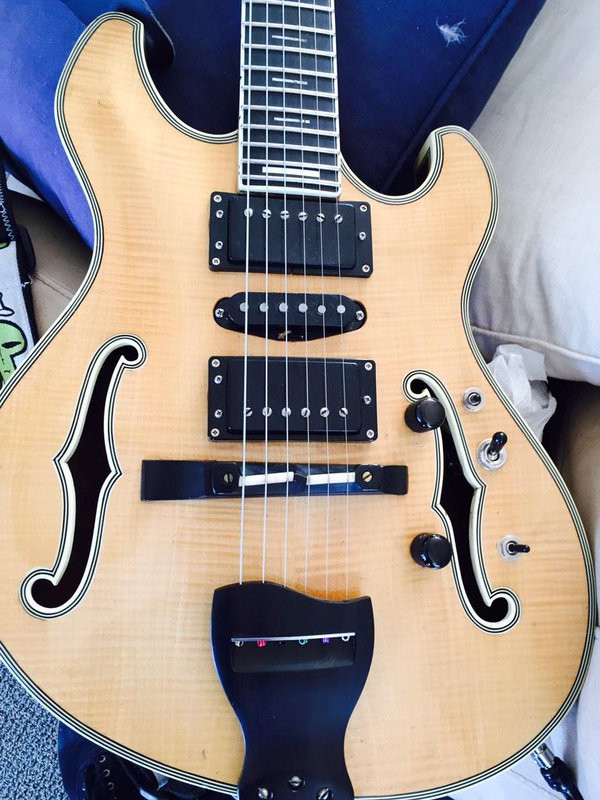 No 1 – Old Reliable
No 1 – Old Reliable
Often referred to as “Blonde No. 1,” this Languedoc was built in 1987 and is Trey’s longest-serving and most iconic electric guitar. Notably, a single-coil pickup was reinstalled for the Fare Thee Well concerts. The headstock features a “Who’s the Mar-Mar?” thought bubble above a Marley inlay. This guitar sports an earlier headstock design, distinct from the Vermont-shaped headstock seen on later Languedocs. “Old Reliable” has been a constant companion throughout Trey’s career, known for its consistent tone and playability, making it a true workhorse on stage and in the studio.
#2: Spruce “I’m the Mar-Mar” (Refurbished 2014)
 033_150102_phish_rene_huemer3Q6A0877
033_150102_phish_rene_huemer3Q6A0877
This guitar, featuring a sunburst refinish, has a unique backstory. Originally built in August 1991 with a spruce top and maple back, it developed a twisted neck and fell out of use. In 2014, Paul Languedoc refurbished the guitar, replacing the neck, applying the sunburst finish, and returning it to Trey. The headstock playfully depicts Marley chasing a cat with an “I’m the Mar-Mar!” thought bubble. Trey publicly recounted the guitar’s history during a 2014 TAB tour performance, highlighting the craftsmanship and dedication Paul Languedoc puts into his instruments.
#3: Koa 1, 1996
 rack close up
rack close up
Koa 1, built in 1996, is easily identifiable by its rectangle inlays and white plastic binding, along with a less pronounced flame in the koa wood. Paul Languedoc’s signature is inlaid on the headstock. Trey has mentioned this was the first Languedoc guitar that truly captivated him. This guitar has seen significant stage time, especially in Phish 3.0 era, becoming a primary instrument. It was famously used almost exclusively during the Baker’s Dozen run at Madison Square Garden, with Koa 2 used sparingly for alternate tunings. Before the 2022 Spring MSG run, Koa 1 received a plek, planing, and refret (Jescar 50×100) service. As of Spring 2022, it features a push-pull knob and TRS output, enabling amplifier head selection directly from the guitar.
#4: Koa 2, 2002
 No 4 – Koa 2.png
No 4 – Koa 2.png
Koa 2, built in 2002, showcases a more prominent flame figure in the koa wood compared to Koa 1. It also features white plastic binding but uses “bracket” inlays at the 12th and 24th frets. Paul Languedoc’s signature is again inlaid on the headstock. Initially thought to be a 1999 build, Paul Languedoc confirmed the year as 2002. Like Koa 1, this guitar received a TRS output and tip/ring switch modification (replacing the series/parallel switch) by 2019, allowing for a stereo output configuration for direct-to-amp and effects rig routing. Koa 2 also underwent a plek, planing, and refret (Jescar 50×100) prior to the 2022 Spring MSG run, ensuring optimal playability.
#5: Ocelot (Koa 3), 2010
This Languedoc, dubbed “Ocelot” or “Koa 3”, was built in 2010. It stands out with an ocelot inlay on the headstock, a highly flamed and darker koa finish, and redwood (or possibly Cocobolo) binding. Trey officially introduced “Ocelot” at the Greek Theatre in Berkeley on August 5, 2010. It features “bracket”-style inlays at the 12th and 24th frets. Fans quickly embraced the guitar, affectionately nicknaming it “Ocedoc.” In November 2020, Koa 3 was modified with a second output jack. The series/parallel switch was replaced with a channel switch for a dual output, similar to Koa 2, enabling simultaneous connection to a direct amp path and effects rig.
#6: Blonde No. 2
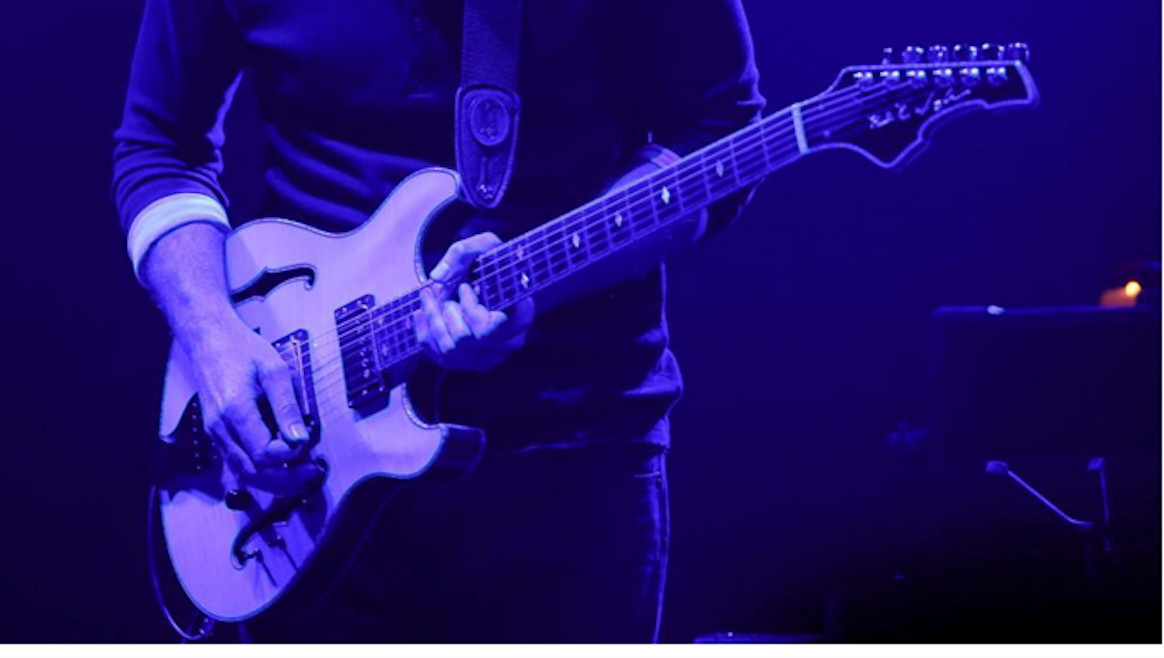 No 6 – spruce 2.png
No 6 – spruce 2.png
“Blonde No. 2” features wood binding and Paul Languedoc’s signature on the headstock. It debuted during Summer Tour 2016. Trey discussed this guitar in an interview with Jambase. It has diamond inlays, with double-diamonds at the 12th and 24th frets. Despite Trey’s initial description of a spruce top, sources close to Paul Languedoc indicate the topwood is actually maple, paired with mahogany back and sides and curly maple binding, aligning with its flamed maple appearance. During the Summer 2019 tour, this guitar was used for “Pebbles and Marbles” in EAEGBD tuning. Before The Beacon Jams, Blonde No. 2 was also modified with a second output, replacing the series/parallel switch with a channel switch for a dual output setup like Ocelot and Koa 2.
#7: The 4.0 Guitar (Koa 4)
 Koa 4
Koa 4
Introduced via social media on January 15, 2021, “The 4.0 Guitar” or Koa 4 was described by Trey as possessing “a glistening harmonic laden high end, a warm fundamental note, and wicked sustain.” Constructed with koa top, back, and sides, it features holly binding instead of plastic (unlike Koa 1 and 2). The fingerboard and tailpiece are ebony, consistent with Languedoc’s typical appointments. A notable feature is the bridge position pickup being positioned closer to the neck pickup compared to Trey’s other Languedocs. Trey expressed deep appreciation for Paul Languedoc’s craftsmanship, stating, “When I play [Paul’s] guitars, I can feel how they were shaped, sanded, molded, and created with love by his bare hands, his soul and spirit. They are beautifully hand-crafted works of art. It’s been the honor of my lifetime to have the privilege of playing them.” Koa 4 features a single mini-switch, speculated to control an a/b configuration used during The Beacon Jams and NYE 19-20 performances, though the exact function is still to be fully confirmed.
 Koa 4 back
Koa 4 back
Trey’s Acoustic Arsenal
Beyond his electric guitars, Trey Anastasio also possesses a remarkable collection of acoustic guitars, featuring vintage Martins and custom instruments. These acoustics are crucial to Phish’s diverse sound and Trey’s solo acoustic performances.
1. 1943 Martin D-28 (Sunburst)
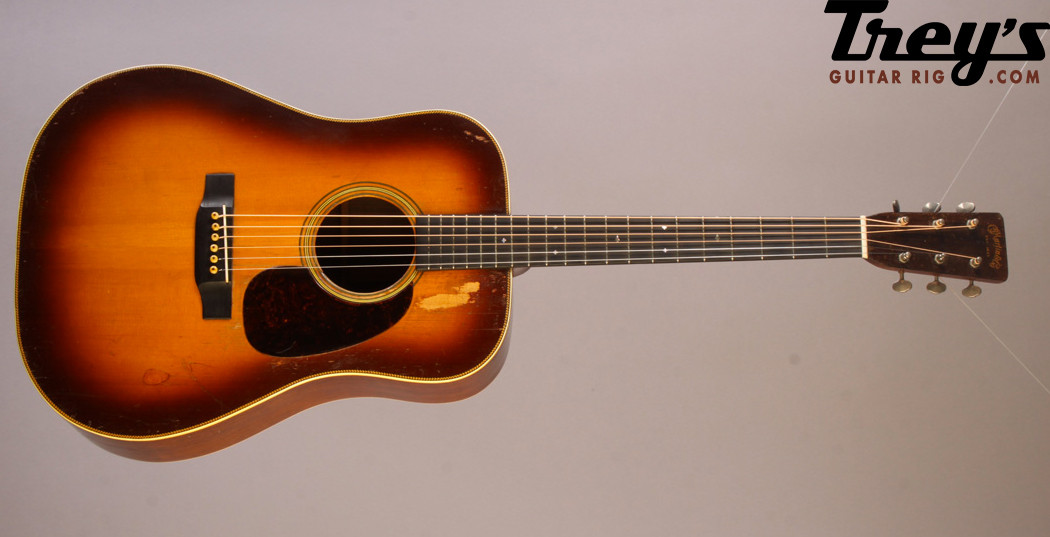 Trey D-28 – Gruhn – WM
Trey D-28 – Gruhn – WM
This nearly pre-war Martin D-28, with an original sunburst finish, has become a favorite of Trey’s. The D-28 is Martin’s flagship dreadnought model, revered by acoustic music icons. This particular guitar is believed to be the same one featured in a Gruhn Guitars ad prior to Trey’s acquisition. Built in 1943, it would have been constructed with Brazilian Rosewood back and sides, a highly sought-after tonewood prized for its rich tonal properties and now under import restrictions in the US.
2. 1968 Martin D-35
 D-35
D-35
Another dreadnought in Trey’s collection, the Martin D-35, differs from the D-28 with its 3-piece back construction compared to the D-28’s 2-piece back. Being a 1968 model, it is also likely constructed with Brazilian Rosewood, adding to its vintage appeal and tonal richness.
3. 1933 Martin 000-28
 1933 000-28
1933 000-28
This vintage 1933 Martin 000-28 is often used for alternate tunings, including open G and DADGAD, and is frequently employed for fingerpicking songs. The 000 body size is smaller and more comfortable for fingerstyle playing compared to dreadnoughts, making it ideal for intricate acoustic passages.
4. Martin Trey Anastasio Signature Model
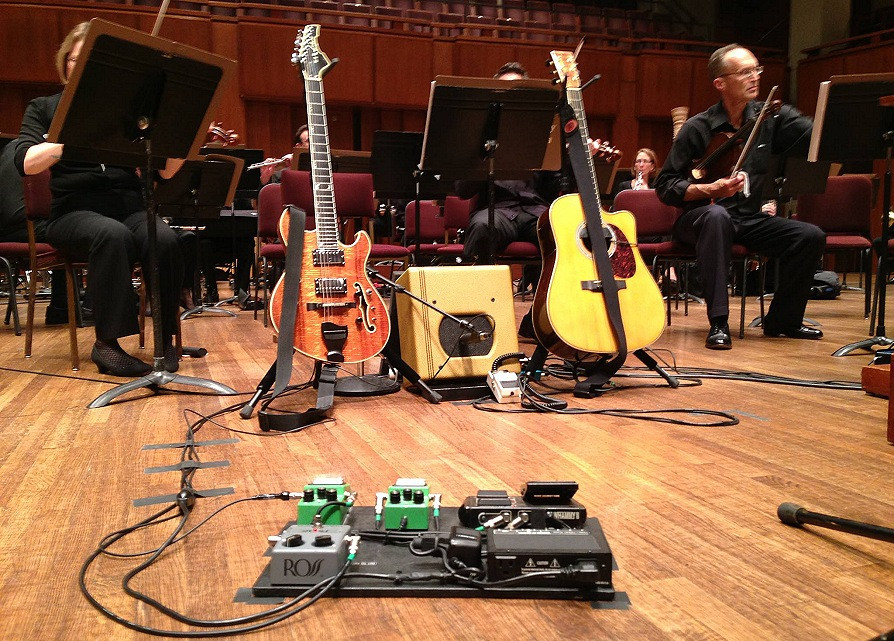 2013 spring – NSO
2013 spring – NSO
This signature model is a collaboration between Martin and Trey Anastasio, featuring a cutaway for enhanced upper fret access. It incorporates rosewood sides and a 3-piece back, similar to a D-35, with koa in the center and rosewood on the sides. This signature model blends traditional Martin craftsmanship with features tailored to Trey’s playing style.
5. 1939 Martin D-18 Authentic
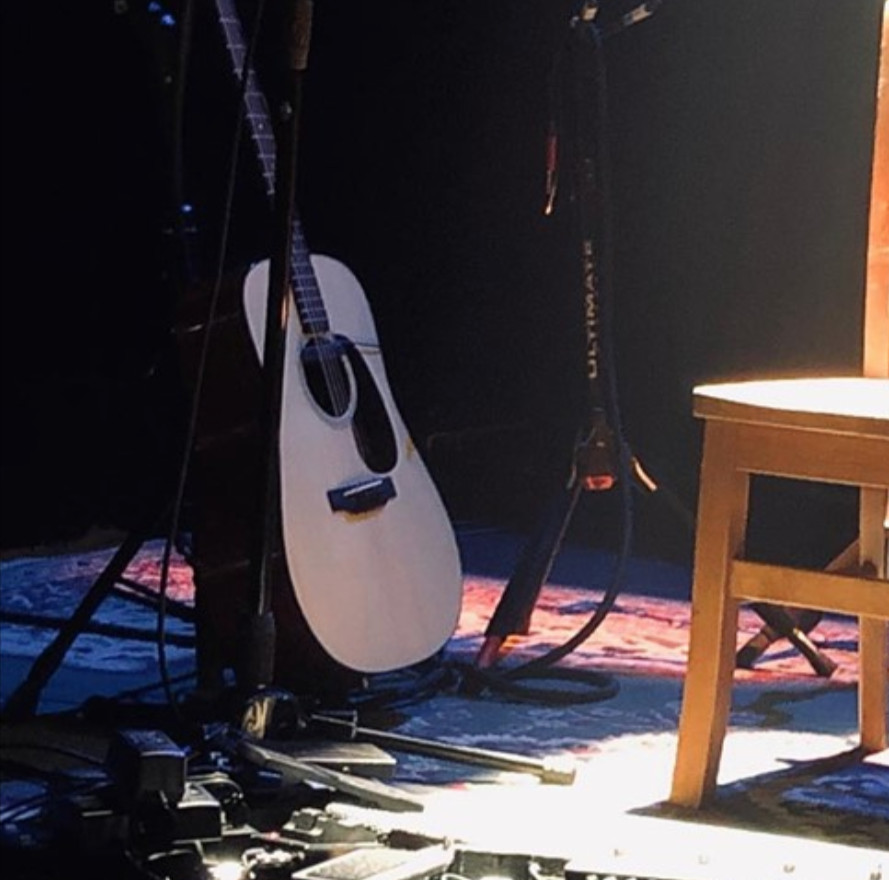 Screen Shot 2019-10-15 at 9.56.51 PM.png
Screen Shot 2019-10-15 at 9.56.51 PM.png
The Martin D-18 Authentic 1939 is a reproduction model, meticulously crafted to recreate the specifications of a vintage 1939 D-18. Trey first publicly used this guitar in December 2018 during his solo acoustic tour. The D-18 is known for its balanced tone and responsiveness, making it a versatile acoustic guitar for various playing styles.
6. Circle Strings Koa Dreadnaught (2021)
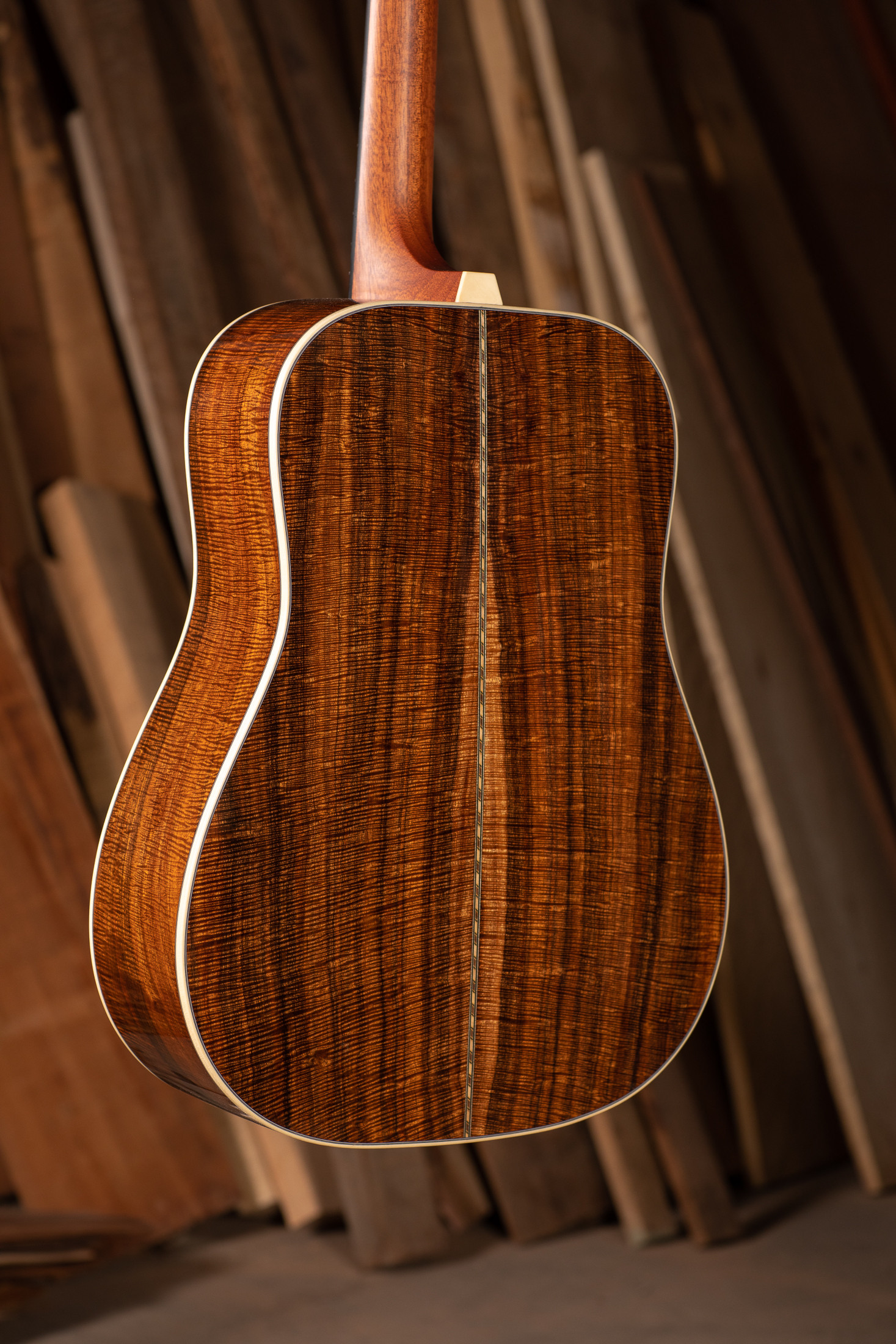 ©ShemRoose7R9A8125
©ShemRoose7R9A8125
This custom Circle Strings Koa Dreadnaught was a birthday gift from Phish keyboardist Page McConnell in 2021. Built by luthier Circle Strings, this guitar is crafted from koa wood and represents a modern addition to Trey’s acoustic collection, showcasing his appreciation for both vintage and contemporary instruments.
Conclusion: The Sound of Trey – Built on Exceptional Guitars
Trey Anastasio’s distinctive guitar sound is a product of his innovative playing style, his effects, and, fundamentally, his exceptional guitars. His collection of Paul Languedoc electric guitars are not just instruments; they are works of art, meticulously crafted to deliver a unique and versatile tone that has become synonymous with Phish’s music. Paired with his prized vintage and custom acoustic guitars, Trey’s guitar collection is a testament to his dedication to tone and his ongoing pursuit of sonic exploration. For fans and guitar players alike, understanding Trey Anastasio’s guitars offers a deeper appreciation for the nuances of his sound and the artistry behind his music.
